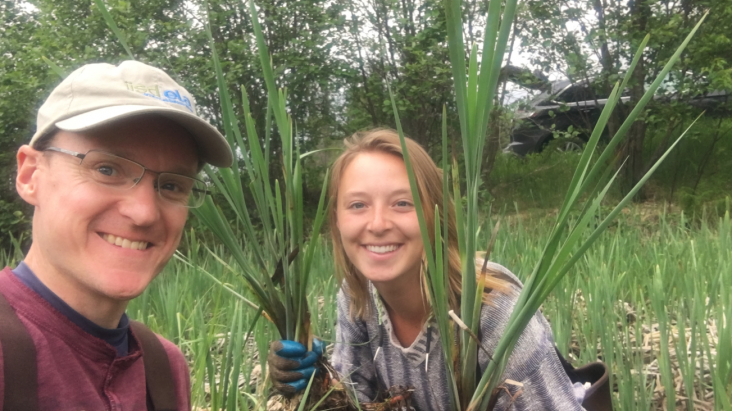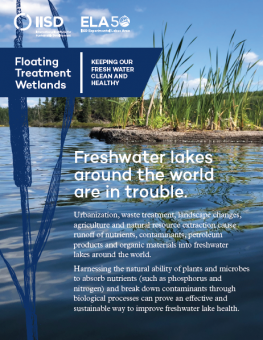Floating Treatment Wetlands
Floating treatment wetlands can help keep our fresh water clean and healthy.
Freshwater lakes around the world are in trouble.
Urbanization, waste treatment, landscape changes, agriculture and natural resource extraction cause runoff of nutrients, contaminants, petroleum products and organic materials into freshwater lakes around the world.

Floating treatment wetlands (FTWs) or islands are small artificial platforms that allow aquatic plants to grow in water that is typically too deep for them. The unique ecosystem that develops creates the potential to capture nutrients and transform common pollutants that would otherwise plague and harm our lakes into harmless by-products.
For the past decade, our research has explored sustainable water and land management that both creates opportunities for economic growth and improves the environment. We have shown that, by harvesting cattail, nutrients (such as phosphorus) taken up during growth and stored within the plant are permanently removed from the soil.
Some of our results have been staggering!
When we placed a series of FTWs in two lakes at IISD Experimental Lakes Area, we intentionally selected one lake that was high in phosphorus (Lake 227) and one that had normal levels (Lake 114).
We discovered that the cattail plants in Lake 227 had eight times the productivity and five times the amount of roots than those left in Lake 114, and four times the amount of phosphorus. This clearly evidences the effectiveness of FTWs in removing excess phosphorus from lakes.
We are now exploring the potential for FTWs to help clean up oil spills (of crude oil and diluted bitumen) in a planned study at IISD Experimental Lakes Area.
Over the last few years, we have deployed a number of floating wetlands in various locations, from the IISD Experimental Lakes Area in northwestern Ontario for research to a “realworld” application in a residential stormwater pond in Lorette, Manitoba. We are also collaborating with other organizations, for example with Assiniboine Park in Winnipeg on the new FTW they deployed in their duck pond.
Floating Treatment Wetlands: Keeping our fresh water clean and healthy
This short, engaging storybook takes you through what Floating Treatment Wetlands are, and how they could really help us keep bodies of fresh water clean and healthy.

How to Build a Floating Wetland
Not only do floating wetlands look super cool, they could help us keep fresh water free of whole range of pollutants—maybe even oil spills! Madeline and Richard take us through how to make one, in this short video.

Floating Treatment Wetlands: Keeping our fresh water clean and healthy
We explain how, where and why floating treatment wetlands can be used to keep freshwater bodies clean around the world.
Latest
You might also be interested in
IISD Experimental Lakes Area
Featuring a collection of 58 small lakes and their watersheds in Northwestern Ontario, Canada, IISD Experimental Lakes Area is one of the world’s most influential freshwater research facilities.
Scientists from Two Continents Working Together to Improve the Health of the African Great Lakes
World-class scientists and researchers from across North America and Africa are putting their heads together to tackle some of the most pressing issues facing the African Great Lakes today.
AquaHacking Lake Winnipeg
We are challenging young innovators to team up and develop new and innovative solutions to tackle urgent freshwater issues.
Lower Winnipeg River Basin: An opportunity to improve the health of our waters
The Winnipeg River and its basin present an economic opportunity—conserving the clean and clear waters can grow the tourism industry of the region, while reaffirming the social licence of resource industries can enhance collaboration and understanding between water users.

